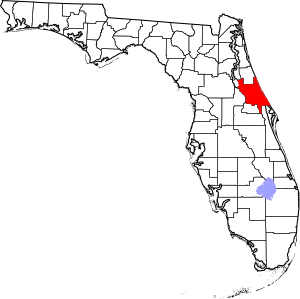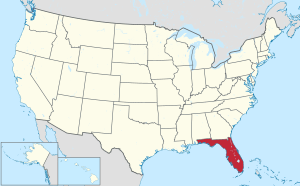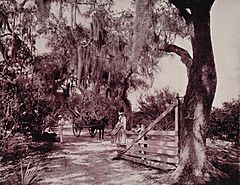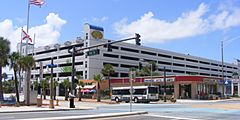Volusia County, Florida facts for kids
Quick facts for kids
Volusia County
|
||
|---|---|---|
| County of Volusia | ||

Volusia County courthouse in DeLand, built in 2001
|
||
|
||

Location within the U.S. state of Florida
|
||
 Florida's location within the U.S. |
||
| Country | ||
| State | ||
| Founded | December 29, 1854 | |
| Named for | Community of Volusia | |
| Seat | DeLand | |
| Largest city | Deltona |
|
| Area | ||
| • Total | 1,432.44 sq mi (3,710.0 km2) | |
| • Land | 1,101.03 sq mi (2,851.7 km2) | |
| • Water | 331.40 sq mi (858.3 km2) 23.14% | |
| Population | ||
| • Estimate
(2019)
|
553,284 | |
| • Density | 489/sq mi (189/km2) | |
| Time zone | UTC−5 (Eastern) | |
| • Summer (DST) | UTC−4 (EDT) | |
| Congressional district | 6th | |
Volusia County ( və-LOO-shə) is located in the east-central part of the U.S. state of Florida, stretching between the St. Johns River and the Atlantic Ocean. As of the 2020 census, the county was home to 553,543 people, an increase of 11.9% from the 2010 census. It was founded on December 29, 1854, from part of Orange County, and was named for the community of Volusia, located in northwestern Volusia County. Its first county seat was Enterprise. Since 1887, its county seat has been DeLand.
Volusia County is part of the Deltona–Daytona Beach–Ormond Beach metropolitan statistical area, and is also part of the larger Orlando–Deltona–Daytona Beach combined statistical area.
History

Volusia County was named after the then-largest-community, Volusia, when the Florida legislature divided Orange County on December 29, 1854. At the time, Volusia County had as few as 600 residents.
The origins of the word "Volusia" are unclear, though there are several theories:
- The name came from a word meaning "Land of the Euchee," from the Euchee Indians who migrated into the area after the Timucua Indian cultures faded away in the early 1700s. The Euchees (or Uchees) lived in the area of Spring Gardens, about ten miles south of Volusia.
- The name was taken from a British man named Voluz who owned a plantation located on the St. Johns River in the late 1700s.
- The name originated from the last name Veluche belonging to the French or Belgian owner of the trading post in Volusia. According to some, this was during the British regime, and according to others, it was around 1818. Over time, the name Veluche became anglicized to Volusia.
- The town was established by and named for Jere Volusia.
- The settlement was named by the Spanish after the celebrated Roman jurist Volusio, who wrote 30 books and tutored Marcus Aurelius, the Roman emperor and philosopher.
The land area of present-day Volusia County was inhabited by the indigenous Timucua, and Mayaca people . Neither group exists today as distinct racial entities, having been decimated by war and disease after contact with European settlers. Evidence of their habitation can still be seen in various areas of Volusia County such as the large shell middens at Tomoka State Park.
During the British occupation of Florida, a failed colony was started in southeast Volusia County by Andrew Turnbull, known as New Smyrna. This colony was connected to St. Augustine, the capital of East Florida, via the Kings Road. After the failure of the colony the settlers, many of Minorcan and Greek heritage made the 70-mile (110 km) journey to live in St. Augustine.
The Seminole Indians, descendants of the Creek tribe of Alabama and Georgia who resisted forced relocation to Indian Territory also camped in various parts of Volusia County. During the Second Seminole War (1836–1842) a large sugar plantation in what is today the city of Daytona Beach was burned by the Seminole.
On the east shore of the St. Johns River in Volusia, in present-day DeBary, General Winfield Scott established a fort/depot in 1836 named Fort Florida.
Geography
According to the U.S. Census Bureau, the county has a total area of 1,432 square miles (3,710 km2), of which 1,101 square miles (2,850 km2) is land and 331 square miles (860 km2) (23.1%) is water.
Volusia County is bordered on the west by the St. Johns River and Lake Monroe, and by the Atlantic Ocean to the east. Roughly the size of Rhode Island, Volusia is situated 50 miles (80 km) northeast of Orlando, 60 miles (97 km) north of the Kennedy Space Center, and 89 miles (143 km) south of Jacksonville.
Regions
The Volusia County Government divides the county into three regions. This parallels the three calling regions used by BellSouth, the regional phone company:
East Volusia - also known as the Greater Daytona Beach Area, or the Halifax Area (named for the Halifax River which runs through the area), this region includes the cities of Daytona Beach, Daytona Beach Shores, Holly Hill, Ormond Beach, Ponce Inlet, Port Orange and South Daytona; and the surrounding unincorporated areas close to these cities.
Southeast Volusia - also known as the Greater New Smyrna Beach Area, this region includes the cities of New Smyrna Beach, Edgewater, and Oak Hill; also the unincorporated areas close to these cities.
West Volusia - also called Saint John's River Country (named for the Saint John's River which lies nearby), this region includes the cities of Barberville, DeBary, DeLand, DeLeon Springs, Deltona, Glenwood, Enterprise, Lake Helen, Orange City, Pierson, and Seville; as well as the surrounding unincorporated areas close to these cities. Deltona is the largest city in Volusia County.
Adjacent counties
- Flagler County - north
- Brevard County - south
- Orange County - south
- Seminole County - southwest
- Lake County - west
- Marion and Putnam counties - northwest
Parks and gardens
- Blue Spring State Park
- Bulow Creek State Park
- Canaveral National Seashore
- De Leon Springs State Park
- Dunlawton Plantation and Sugar Mill
- Gemini Springs Park
- Green Springs Park
- Hontoon Island State Park
- Lake George State Forest
- Lake Woodruff National Wildlife Refuge
- North Peninsula State Park
- Tiger Bay State Forest
- Tomoka State Park
Rivers and waterways
Major attractions
- Daytona International Speedway in Daytona Beach
- Jackie Robinson Ballpark in Daytona Beach
- New Smyrna Speedway in New Smyrna Beach
- Ponce de Leon Inlet Lighthouse and Museum in Ponce Inlet
- The Ocean Center (convention center) in Daytona Beach
- Volusia County Fair and Expo Center in DeLand
- Volusia Speedway Park in Barberville
Demographics
| Historical population | |||
|---|---|---|---|
| Census | Pop. | %± | |
| 1860 | 1,158 | — | |
| 1870 | 1,723 | 48.8% | |
| 1880 | 3,294 | 91.2% | |
| 1890 | 8,467 | 157.0% | |
| 1900 | 10,003 | 18.1% | |
| 1910 | 16,510 | 65.1% | |
| 1920 | 23,374 | 41.6% | |
| 1930 | 42,757 | 82.9% | |
| 1940 | 53,710 | 25.6% | |
| 1950 | 74,229 | 38.2% | |
| 1960 | 125,319 | 68.8% | |
| 1970 | 169,487 | 35.2% | |
| 1980 | 258,762 | 52.7% | |
| 1990 | 370,712 | 43.3% | |
| 2000 | 443,343 | 19.6% | |
| 2010 | 494,593 | 11.6% | |
| 2019 (est.) | 553,284 | 11.9% | |
| U.S. Decennial Census 1790–1960 1900–1990 1990–2000 2010–2019 |
|||
As of the census of 2000, 443,343 people, 184,723 households, and 120,069 families were residing in the county. The population density was 402 people per square mile (155/km2). The 211,938 housing units averaged 192 per square mile (74/km2). The racial makeup of the county was 86.11% White, 9.29% African American, 0.31% Native American, 1.00% Asian, 1.86% from other races, and 1.43% from two or more races. About 6.57% of the population were Hispanic or Latino of any race; ancestry was 13.7% German, 11.5% Irish, 11.2% English, 10.7% American, and 8.7% Italian ancestry.
Of the 184,723 households, 24.10% had children under the age of 18 living with them, 50.40% were married couples living together, 10.90% had a female householder with no husband present, and 35.00% were not families. About 27.90% of all households were made up of individuals, and 13.60% had someone living alone who was 65 years of age or older. The average household size was 2.32, and the average family size was 2.82.
In the county, the age distribution was 20.30% under 18, 8.20% from 18 to 24, 25.30% from 25 to 44, 24.20% from 45 to 64, and 22.10% at 65 or older. The median age was 42 years. For every 100 females, there were 94.50 males. For every 100 females age 18 and over, there were 91.80 males.
The median income for a household in the county was $35,219, and for a family was $41,767. Males had a median income of $30,573 versus $22,471 for females. The per capita income for the county was $19,664. About 7.90% of families and 11.60% of the population were below the poverty line, including 16.30% of those under age 18 and 7.10% of those age 65 or over.
2016
As of 2016, an estimated 205,310 households were in Volusia County. The total population was 510,806. About 86.8% spoke English as their only language, so 13.2% could speak a language other than English. The largest ancestry groups in the county were English-American at 15.7%, German-American at 12.3%, Irish-American at 11.0% and Italian-American at 7.0%.
Transportation
Airports
- Daytona Beach International
- DeLand Municipal Airport
- Massey Ranch Airpark
Major roads
 Interstate 95 is the main north–south interstate highway along the east coast of the state. Eight interchanges exist within the county, three of them in Daytona Beach.
Interstate 95 is the main north–south interstate highway along the east coast of the state. Eight interchanges exist within the county, three of them in Daytona Beach. Interstate 4 is the main east–west interstate highway through Central Florida, but it also serves as the westernmost interstate highway in the county. It contains at least seven interchanges and becomes State Road 400 east of I-95.
Interstate 4 is the main east–west interstate highway through Central Florida, but it also serves as the westernmost interstate highway in the county. It contains at least seven interchanges and becomes State Road 400 east of I-95. U.S. 1 is the main local road through eastern Volusia County, running north–south. It served as the main north–south highway in the state and the eastern half of the county until I-95 was built.
U.S. 1 is the main local road through eastern Volusia County, running north–south. It served as the main north–south highway in the state and the eastern half of the county until I-95 was built. US 17 is the main local road through western Volusia County, running north–south.
US 17 is the main local road through western Volusia County, running north–south. US 92, an east–west route, shares a concurrency with US 17 further south in Polk County until branching off onto the International Speedway Boulevard.
US 92, an east–west route, shares a concurrency with US 17 further south in Polk County until branching off onto the International Speedway Boulevard. SR A1A is the scenic coastal alternate route to US 1, which also includes some county road spurs and extensions.
SR A1A is the scenic coastal alternate route to US 1, which also includes some county road spurs and extensions. SR 40, an east–west road in northern Volusia County enters the county from the Astor Bridge over the St. Johns River and heads east towards Ormond Beach.
SR 40, an east–west road in northern Volusia County enters the county from the Astor Bridge over the St. Johns River and heads east towards Ormond Beach. SR 44, an east–west road in southern Volusia County, enters the county from the Crows Bluff Bridge over the St. Johns River and heads east towards New Smyrna Beach.
SR 44, an east–west road in southern Volusia County, enters the county from the Crows Bluff Bridge over the St. Johns River and heads east towards New Smyrna Beach. SR 46, an east–west road on the southwestern corner of Volusia County, enters the county from the Mims Bridge over the St. Johns River and enters Brevard County with no major junctions.
SR 46, an east–west road on the southwestern corner of Volusia County, enters the county from the Mims Bridge over the St. Johns River and enters Brevard County with no major junctions. SR 5A is Nova Road, a suffixed alternate route of State Road 5, the unsigned hidden state road for US 1. It spans from Port Orange to Ormond Beach.
SR 5A is Nova Road, a suffixed alternate route of State Road 5, the unsigned hidden state road for US 1. It spans from Port Orange to Ormond Beach. SR 421 is a connecting east–west road between I-95 and the Port Orange Causeway.
SR 421 is a connecting east–west road between I-95 and the Port Orange Causeway. SR 11, a scenic north–south road, runs from US 17 north of DeLand to US 1 in Bunnell in Flagler County.
SR 11, a scenic north–south road, runs from US 17 north of DeLand to US 1 in Bunnell in Flagler County. SR 483, a north–south state road, it runs west of SR 5A from Port Orange to Holly Hill. It runs along the eastern border of both Daytona Beach International Airport and Daytona International Speedway.
SR 483, a north–south state road, it runs west of SR 5A from Port Orange to Holly Hill. It runs along the eastern border of both Daytona Beach International Airport and Daytona International Speedway.
Public transportation
Volusia County Public Transit System (VOTRAN) is the local Volusia County bus service. The buses offer service throughout the county, Monday through Saturday, from 7 am to 7 pm, and is handicapped-accessible. Limited service is offered in East Volusia in the evenings and on Sundays. The cost is $1.25 per trip, $3.00 for a one-day bus pass, or $40 for a 31-day pass (valid for all VOTRAN routes).
Passenger train service to Volusia County is provided by Amtrak on the Silver Meteor and Silver Star routes. Service between Volusia County and Orlando is provided by SunRail, a commuter rail line running from Volusia to Orange County. The initial phase of the project commenced in 2014 and extends service to as far north as DeBary. A planned expansion was to include the DeLand Amtrak station in 2015.
Places
Cities
Towns
Census-designated places
Other unincorporated communities
- Alamana
- Ariel
- Bakerstown
- Barberville
- Benson Junction
- Beresford
- Bethune Beach
- Blake
- Blue Springs Landing
- Bluffton
- Boden
- Cassadaga
- Cabbage Bluff
- Connersville
- Conrad
- Cow Creek
- Creighton
- Cypress Lake Estates
- Daisy Lake
- Daytona Highridge Estates
- Daytona Park Estates
- Deadman Landing
- DeLand Highlands
- DeLeon Springs Heights
- Edgewater Junction
- Eldora
- Eldridge
- Ellinor Village
- Emporia
- Enterprise
- Farmton
- Fatio
- Fort Florida
- Glenwood
- Halifax Estates
- Harbor Oaks
- Hucomer
- Isleboro
- Kalamazoo
- Lake Ashby Shores
- Lemon Bluff
- Maytown
- Mission City
- Mound Grove
- National Gardens, Florida
- Orange City Hills
- Ortona
- Osteen
- Packwood Place
- Pennichaw
- Riverside
- Seabreeze
- Senyah
- Stone Island
- Sugar Mill Estates
- Tomoka Estates
- Valdez
- Volusia
- Wilbur By-The-Sea
Economy
The overall gross metro product (GMP) for Volusia County economy increased from $12.98 billion in 2005 to $13.69 billion in 2006; a $709.9 million increase. The GMP is an annual measurement of the total economic output and sales of goods and services provided within the metropolitan statistical area that comprises all of Volusia County and its 16 cities. A GMP of $13.69 billion represents a significant circulation of new capital resources in an economy populated by just over 500,000 residents.
Local consumer confidence and a continued immigration of an estimated 28,800 new residents, new capital investments for new construction exceeding $1.11 billion, and the steady growth of professional and health-care services continued to drive much of the county's economic viability.
Volusia County's manufacturing sector maintained a steady and stable position within the local economy contrary to the declining trends being experienced elsewhere within Florida. The overall number of manufacturers present within the county increased to over 430 in 2006 and accounted for a large portion of the county's GMP. Manufacturing maintains one of the highest of all average wage levels within the county and generates a higher rate of circulation of economic impact than any other business sector that comprises the local economy.
Volusia County's manufacturing sector generated an average annual wage of $37,632 in 2006, well above the county's average annual wage of $32,200 for all workers. [1]
Education
Public primary and secondary education is handled by Volusia County Schools. One of the larger private schools is Father Lopez Catholic High School.
Middle schools
- Campbell Middle School
- Creekside Middle School
- David C. Hinson Middle School
- DeLand Middle School
- Deltona Middle School
- Galaxy Middle School
- Heritage Middle School
- Holly Hill School
- New Smyrna Beach Middle School
- Ormond Beach Middle School
- River Springs Middle School
- Silver Sands Middle School
- Southwestern Middle School
- T. Dewitt Taylor Middle High School
High schools
- Atlantic High School
- DeLand High School
- Deltona High School
- Mainland High School
- New Smyrna Beach High School
- Pine Ridge High School
- Seabreeze High School
- Spruce Creek High School
- T. Dewitt Taylor Middle High School
- University High School
- Volusia High School
Colleges and universities
- Bethune-Cookman University
- Daytona State College
- Embry-Riddle Aeronautical University
- Keiser University
- Palmer College of Chiropractic
- Stetson University
- University of Central Florida
Vocational
- Advanced Technology College
- Epic Flight Academy
- International Academy Beauty School
- Florida Technical College
- Palmer College of Chiropractic
- Phoenix East Aviation
- The Airline Academy
- WyoTech
See also
 In Spanish: Condado de Volusia (Florida) para niños
In Spanish: Condado de Volusia (Florida) para niños






